Sergeant Sidney Jordan – Lote Loesgeldova – Theresienstadt
Three lovely photos from a very much earlier era, firstly Sidney with his Mother and Father, then at his Christening (1917) and finally playing Pirates with his brother (1930) Sidney is on the right.



Sidney Jordan, he was known more often by the family as 'Jack'

Prior to the war Sidney was a Policeman with the Metropolitan Force, based at Richmond Upon Thames. He was a athletic man, enjoying both cycling and swimming (through which he met Lote in August 1938). Here he is ready for a jaunt on his bicycle and a great photo which has an 'air' of New York during the prohibition era, but which was taken in London prior to him enlisting (in this photograph he is 17)
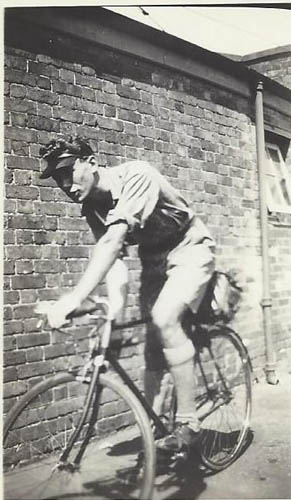

My favourite, and only recently discovered, photo of Sidney prior to the war. Proudly wearing his Police Uniform.

Having joined the RAF, Sidney, like many, was sent to Canada for training, here he is with two fellow 'trainee's' taken in 1941.
A great intake photo with Sidney back row, almost centre. To his left is Corbell/Cordell, an airmen by this name flew on one raid with Drummond Wilson, it's a fair bet it's him. Bottom front right Flying Officer MacDonald is another who is linked to XV Squadron

Two more photos from Canada in 1941, in the first Sidney is back row second left, in the second he's back row fourth from the right.


At home and on the right out for a stroll in Torquay. Torquay was a favourite resort for recovering RAF personnel, Clifford Reeve spent time here after the Godmanchester crash. Perhaps that explains Sidney's visit?


A photo with no caption, could this be some of Sidney's fellow crewmen ? It would be great to identify them.

The graves of Sidney and his fellow crew in Hanover War Cemetery, lost on a raid over Duisberg.


Lote Losegeldova and her Family:
Lote and her family lived in Prostejov in Moravia, a town with a vibrant Jewish population who ran many successful businesses in the area. Lote met The Godmanchester Stirling Bomb Aimer Sidney Jordan in August 1938 and they struck up a relationship whilst she was staying with her Aunt in Wimbledon. She kept in touch through letters after she returned home but the annexation of Czechoslovakia brought their relationship to an end. Sidney's family have three pictures she sent to him back in England, one is in the book. These are the other two. On the portrait picture, dated 20th May 1939, she wrote 'Prostejov, from your Lotte. The 'beach' photo was dated 18th July 1939, she simply wrote 'The last one of me, your Lotte'. It's very likely that this photo was taken at Plumlov Lake some five miles to the west of Prostejov. Plumlov Lake was a favourite place for people of all ages to swim and sunbathe.
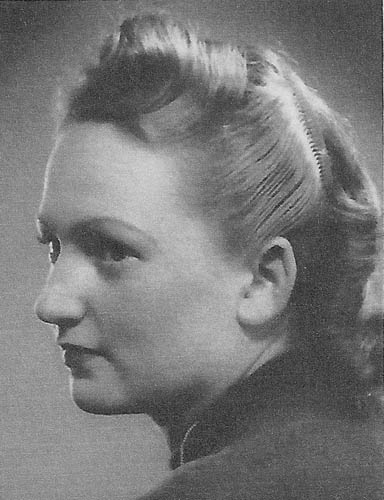

Two buildings that meant a lot to Lote, left is the building which housed the families flat (No 22) on Komensky Street, Prostejov. The second photo is of the family's business premises which were eventually taken over by Leo Pollak. Ilse, Lote's sister, married his brother Walther.


Lote's sister, Ilse, relaxing in a deckchair, probably at Plumlov Lake, and a lovely portrait

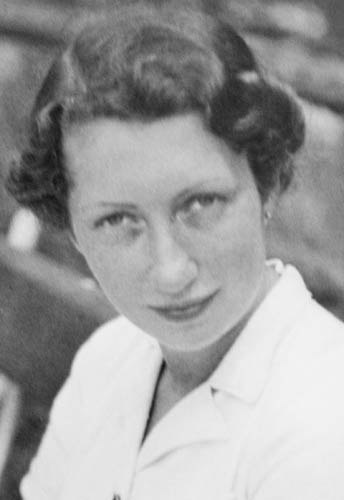
A happy day for the Loesgeld and Pollak families as Ilse marries Walther Pollak on the 25th July 1937. Lote is left, with Ilse in the middle, and another of Ilse on her own.


A painting by Ferdinand Waldmuller painted in 1824 and titled 'Young lady in a Turban being presented with a Jewellery box'. This painting was the property of Lote's parents until they were sent to Theresienstadt in 1942. It disappeared after that and is on the lost artworks register. Following their transport to Theresienstadt their apartment was occupied by Oberfuhrer Ernst Brandstatter.
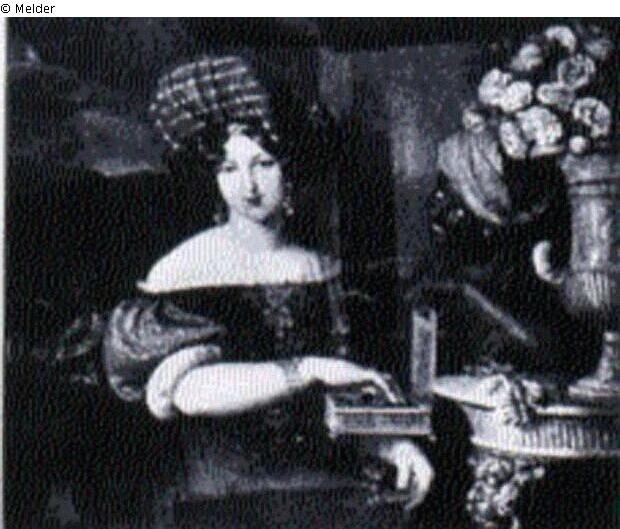
Theresienstadt (Terezin) Visit : April 2017
Michele and I had finally decided to pay Prague a visit having heard such good things about it, and we weren't disappointed. Whilst we were there we planned a trip to Terezin, being only an hour away by train it seemed that visiting the town where Lota and her family had been incarcerated was something we just had to do. On a sunny morning we left Prague heading out towards the city of Decin, soon the city drifted away and we followed the course of the Vltava River, sometimes open countryside, other times steep cliffs loomed above the tracks. We passed hundreds of quaint houses, almost alpine, each had their own small orchard and vegetable patches.
The train was a throw back to 1960's British Rail, individual compartments, with a ancient but functional toilet at the end of each carriage. Eventually the landscape opened up into a vast plain, after numerous stops, some of which were towns and villages, and other occasions the stop was nothing more than a 3 metre platform with a bus shelter, we pulled into the station at Bohusovic Nad Ohri. The main building was old enough to have been there during the war, and nearby some old railway sheds added to the sense of a history best forgotten. It was here that the 'transports' arrived with their hundreds of occupants, and where, later in the war, the transport's left for Auschwitz. One of which contained only children, some so young they had to be carried by the older ones. What horrors this quiet station witnessed.



We were still some three kilometers away from Terezin, but our arrival fortunately coincided with a tour who were waiting for a local bus. Fifteen minutes later the bus pulled into the town of Terezin. Terezin was originally constructed as a garrison town in the 1800's, and was built on a grid system. Refreshed with a coffee at practically the only Cafe we could find, we set out to find out more about this lifeless town. Our first stop was at the Ghetto Museum, here I met with Tomas Fedorovic, manager of the Pamatnik Terezin (Terezin Monument). He was able to identify areas we should visit which connected with Lota's story. We were also able to look through the huge collection of art that had been produced by those who passed through its maze of dormitories. Art was so important, giving those interned an opportunity to record their lives. Many of these pieces were hidden inside the ghetto only to be uncovered many decades later.

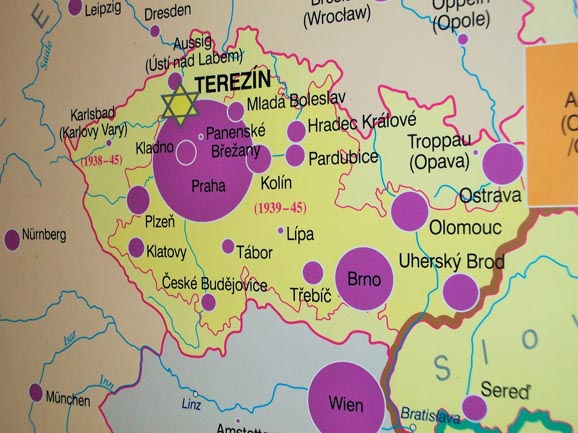
The map outlining the Terezin ghetto, inside the museum showing the areas where the jewish population centres prior to the war. Lota's family came from Prostejov, close to the city of Olomouc. Her mother was born in Uhersky Brod.


Myself with Tomas in the Ghetto museum and a layout of the Terezin Barrack town showing its carefully constructed grid system.
Inside the museum was a room with seven panels called 'The Wall of Children', each wall carried the names of children who passed through Terezin during the war. The vast majority of which were transported to the extermination camps. The left picture gives an idea as to the sheer number of children on just one of the panels, on the right is the entry for Petr Pollak, Lota's young nephew. 15,000 children passed through Terezin, less than 150 survived the ordeal.


The Barrack Town of Terezin


Whilst it was clean, well presented and obviously lived in, the whole town had an empty feeling to it. Terezin was not a constructed concentration camp, but rather a Ghetto without walls, guarded yes, but not ringed by barbed wire and machine gun towers. The threat of reprisals against loved ones was sufficient to keep people where they were. And whilst local Czech prisoners might get away with hiding amongst the population (if anyone dared to help) Jews from other countries would never fit in and would soon be caught. On one occasion four young me, all German Jews, did escape. We don't what happened to them, but the whole of the Ghetto feared reprisals. Fortunately the Commandant's punishment was the banning for one month all entertainment. It might seem a lenient punishment, but for the Jews of Terezin this was the only 'normality' they knew so it was would have had a effect on morale.
Here and there some of the old buildings that stood during the war and had changed little caught our attention.



One building housed examples of the dormitories where thousands were crammed in. Lack of food, cramped conditions and disease were soon to take their toll on those poor souls who were kept there. When the Red Cross, seeking assurance as to conditions in Terezin, decided to visit and see for themselves the Germans solved the overcrowding issue by removing the top bunks and sending all those to Auschwitz. The Red Cross, suitably reassured, gave the camp a good review.



The museum holds a vast art collection, as mentioned previously, they cover the whole range of life within Terezin, many as you can imagine are heartbreaking and difficult to look at, whilst others show everyday life and occasionally dark humour and a lighter side. The the pictures of the Cafe were of particular interest as I was aware from Lota's story that she had indeed enjoyed spending time there, listening to Jazz and Classic music, escaping from the camp outside and just for a moment casting aside her incarceration and the horrors that came with it.
Michele spotted it first, now a supermarket run by a Chinese family. Outside is the original Ghetto building number, one of the few still remaining



Two drawings made by the same artist who had spent some time in the Cafe, for a brief time some level of normality could be had. Tickets were hard to come by, and were highly valued.


And today, a grocers. No clue to the hope this building once delivered


The first plaque is on the town hall in Terezin, the second is on the wall of the railway station at Bohusovic Nad Ohri


The last bus back to the railway station left at 5.20pm, and as we didn't fancy a long bus trip back to Prague, we made sure we caught it.
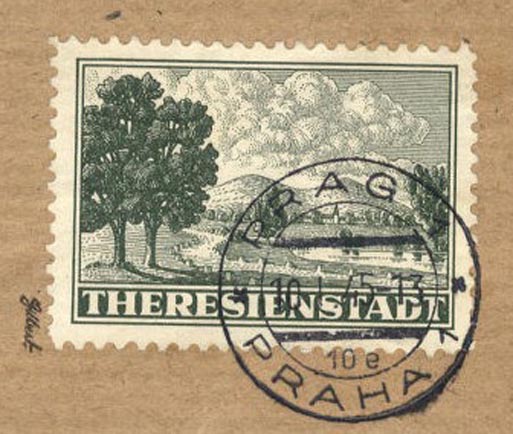
Lota's fiance, Frantisek Urban, was working in Prague during this time, but he supported her with food parcels which he sent to Terezin using specially printed stamps. Here is one such stamp, to get these it as necessary to visit the Jewish council in Prague and purchase them, his details would have been recorded and kept on record. So every parcel he sent to Terezin came at great risk to his own safety.
Terezin was a very strange place, it seemed devoid of life, just wide open empty spaces, clearly lived in but not breathing. And to see these Grand buildings painted in pastel colours in the bright Spring sunshine was odd, knowing the suffering that once lived behind those doors. We were glad we visited Terezin, and in some small way it helped me understand a little of what Lota, her family and all those who were sent there went through.
